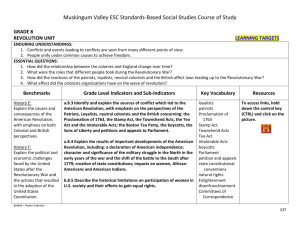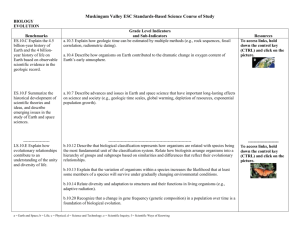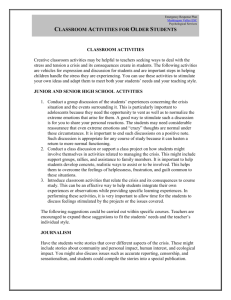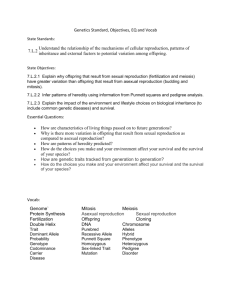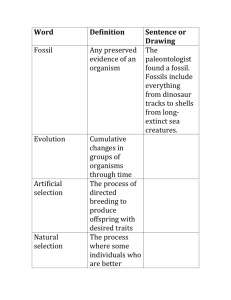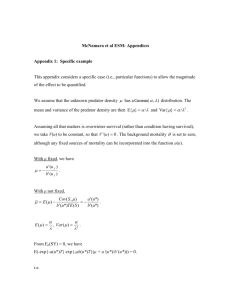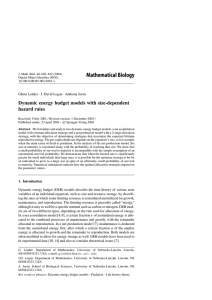Heredity
advertisement
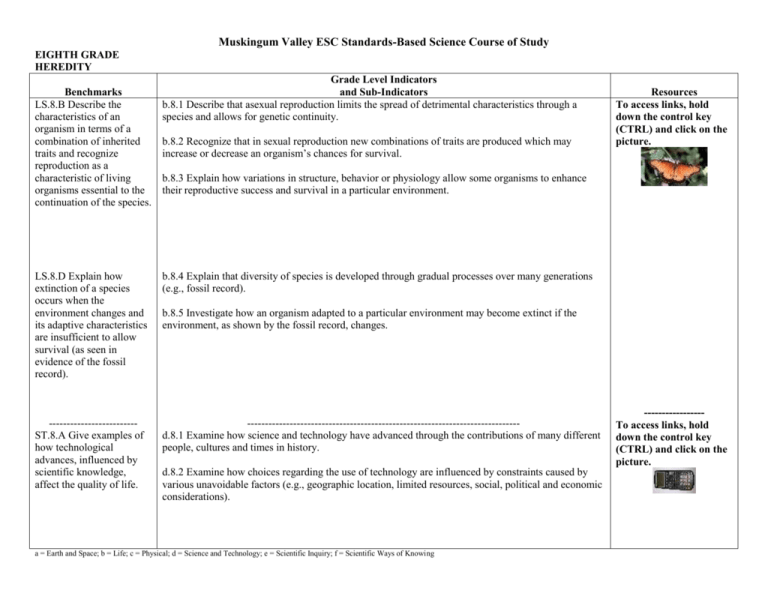
Muskingum Valley ESC Standards-Based Science Course of Study EIGHTH GRADE HEREDITY Benchmarks LS.8.B Describe the characteristics of an organism in terms of a combination of inherited traits and recognize reproduction as a characteristic of living organisms essential to the continuation of the species. Grade Level Indicators and Sub-Indicators b.8.1 Describe that asexual reproduction limits the spread of detrimental characteristics through a species and allows for genetic continuity. b.8.2 Recognize that in sexual reproduction new combinations of traits are produced which may increase or decrease an organism’s chances for survival. Resources To access links, hold down the control key (CTRL) and click on the picture. b.8.3 Explain how variations in structure, behavior or physiology allow some organisms to enhance their reproductive success and survival in a particular environment. LS.8.D Explain how extinction of a species occurs when the environment changes and its adaptive characteristics are insufficient to allow survival (as seen in evidence of the fossil record). b.8.4 Explain that diversity of species is developed through gradual processes over many generations (e.g., fossil record). ------------------------ST.8.A Give examples of how technological advances, influenced by scientific knowledge, affect the quality of life. ----------------------------------------------------------------------------d.8.1 Examine how science and technology have advanced through the contributions of many different people, cultures and times in history. b.8.5 Investigate how an organism adapted to a particular environment may become extinct if the environment, as shown by the fossil record, changes. d.8.2 Examine how choices regarding the use of technology are influenced by constraints caused by various unavoidable factors (e.g., geographic location, limited resources, social, political and economic considerations). a = Earth and Space; b = Life; c = Physical; d = Science and Technology; e = Scientific Inquiry; f = Scientific Ways of Knowing ----------------To access links, hold down the control key (CTRL) and click on the picture. Muskingum Valley ESC Standards-Based Science Course of Study SI.8.A Explain that there are differing sets of procedures for guiding scientific investigations and procedures are determined by the nature of the investigation, safety considerations and appropriate tools. e.8.1 Choose the appropriate tools and instruments and use relevant safety procedures to complete scientific investigations. SI.8.B Analyze and interpret data from scientific investigations using appropriate mathematical skills in order to draw valid conclusions. e.8.3 Read, construct and interpret data in various forms produced by self and others in both written and oral form (e.g., tables, charts, maps, graphs, diagrams, symbols). --------------------------SK.8.B Explain the importance of reproducibility and reduction of bias in scientific methods. ----------------------------------------------------------------f.8.2 Explain why it is important to examine data objectively and not let bias affect observations. e.8.2 Describe the concepts of sample size and control and explain how these affect scientific investigations. To access links, hold down the control key (CTRL) and click on the picture. e.8.4 Apply appropriate math skills to interpret quantitative data (e.g., mean, median, mode). Sub-Indicators: Identify the cell as the basic unit of life. Identify and describe the levels of organization (i.e., cells, tissues, organs, and organ systems). Investigate how a cell takes in nutrients to provide energy for the cell to grow and reproduce (e.g., asexual reproduction, phases of mitosis, diffusion, osmosis, active transport, etc.). Compare and contrast how plants and animals accomplish basic life functions at various levels of organization, including: Respiration; Reproduction; Growth and development; Energy use; Excretion; Circulatin; Digestion; Photosynthesis Create a model of the process of cellular division (mitosis). Define operationally, through experimentation, the basic nature of DNA, chromosomes and genes. Recognize relationships between the work of Gregor Mendel and the laws of genetics. Compare and contrast dominant and recessive traits of an organism. Describe the Law of Segregation (meiosis). Compare and contrast the difference between phenotypes and genotypes. a = Earth and Space; b = Life; c = Physical; d = Science and Technology; e = Scientific Inquiry; f = Scientific Ways of Knowing ------------------------To access links, hold down the control key (CTRL) and click on the picture. Muskingum Valley ESC Standards-Based Science Course of Study Investigate the Law of Independent Assortment to predict the results of genetic crosses (e.g., probability activities, Punnet squares, pedigrees, etc.). Recognize relationships in the process of natural selection and the Describe changes in populations over time incorporating: Natural selection Adaptation Natural variation Mutation Relationships between species Survival of the fittest species (e.g., Peppered Moth’s change of color over time, etc.) Extinction (e.g., dinosaurs, etc.) Discuss ways in which genetic engineering has contributed to medicine and agriculture (e.g., cloning, engineered wheat and beans, stem cell research, etc.). a = Earth and Space; b = Life; c = Physical; d = Science and Technology; e = Scientific Inquiry; f = Scientific Ways of Knowing
